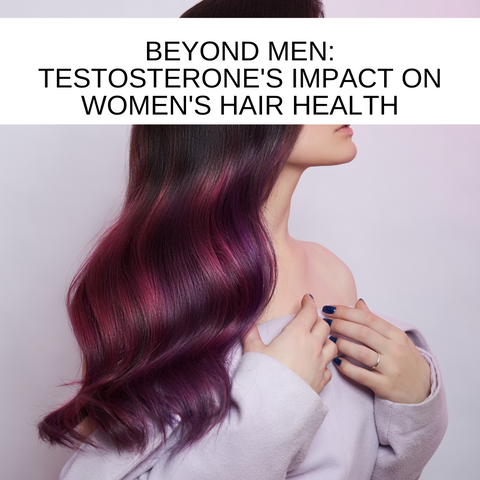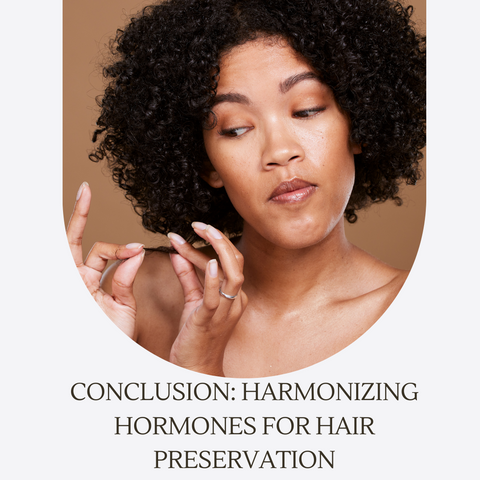Testosterone, a hormone associated predominantly with male features, is important for hair health. In this blog, we will look at how the relationship with hair is complicated and incorporates a number of elements.
The Hair-Testosterone Connection: Unveiling the Biological Links

The biological processes that control hair growth and loss complicate the relationship between testosterone and hair health. The relationship between hair and testosterone is influenced by various factors, including androgen receptors, DHT effects, genetic predisposition, hormonal imbalances, age-related changes, hormonal treatments, and individual differences. Personalised advice and treatment options tailored to address particular hormonal and hair health issues can be obtained by consulting with a healthcare specialist, especially a dermatologist or endocrinologist.
How Testosterone Influences Hair Growth and Loss
Testosterone interacts with hair follicles and is converted to dihydrotestosterone (DHT), which affects hair growth and loss. This is how testosterone affects the growth and thinning of hair:
-
Production of Testosterone: One of the primary hormones linked to masculine traits, testosterone is mostly produced in the testes of men and in smaller quantities in women's ovaries and adrenal glands. Although it is frequently associated with hair growth, its impact on hair varies according to factors like the sensitivity of hair follicles and genetics.
-
Conversion to DHT: The enzyme 5-alpha-reductase transforms testosterone into DHT. DHT is a more powerful androgen that interacts with scalp-specific androgen receptors in hair follicles.
-
Effect on Hair Follicles: The androgen receptors in the hair follicles are more sensitive to DHT in people who have a genetic predisposition to androgenetic alopecia, or male/female pattern baldness. The impacted hair follicles eventually shrink due to a process known as miniaturisation brought on by this sensitivity. Miniaturised follicles produce shorter, finer hairs, eventually causing hair growth to stop in those follicles.
-
Hair Growth Cycle: The hair growth cycle is influenced by testosterone. It promotes hair development by stimulating the growth phase (anagen) of hair follicles. However, because of the influence of DHT, the growth period grows shorter in persons genetically prone to androgenetic alopecia. This causes shorter and thinner hair until the follicles stop producing visible hair.
-
Role in Androgenetic Alopecia: The most prevalent type of hair loss in men and women is androgenetic alopecia. Hair follicles in specific areas of the scalp (usually the frontal and crown regions) gradually become sensitive to the effects of DHT in susceptible individuals. This sensitivity causes hair thinning and, eventually, hair loss.
-
Other Factors: While testosterone and DHT play a significant role in hair loss, other factors such as hormonal imbalances, genetics, age-related changes, and environmental influences also contribute to the manifestation of hair loss.
DHT: The Testosterone Derivative Behind Hair Thinning
Dihydrotestosterone (DHT) is a testosterone derivative that has been linked to hair loss and male/female pattern baldness (androgenetic alopecia). DHT affects hair loss in the following ways:
-
Conversion from Testosterone: The 5-alpha-reductase converts testosterone, a hormone primarily associated with male characteristics, into DHT. This transformation occurs primarily in certain tissues such as the scalp, prostate gland, and skin.
-
Impact on Hair Follicles: DHT, especially in genetically predisposed people, interacts with androgen receptors found in hair follicles. These androgen receptors become more sensitive to DHT in people who are genetically predisposed to androgenetic alopecia.
-
Hair Follicle Miniaturisation: DHT causes susceptible hair follicles to progressively shrink, a phenomenon known as miniaturisation. The affected follicles produce hairs that become thinner, shorter, and lighter in colour over time. These miniaturised follicles may eventually stop producing visible hairs, resulting in hair thinning and the appearance of baldness.
-
Hair Growth Cycle Shortening: In susceptible hair follicles, DHT shortens the growth phase (anagen phase) of the hair growth cycle. As a result, the affected follicles spend less time actively producing hair, resulting in less density and visible thinning.
-
Location Specificity: Androgenetic alopecia frequently affects the frontal and crown regions of the scalp, where the hair follicles are more vulnerable to the effects of DHT. This patterned hair loss is often seen in both men and women.
-
Treatment Methods: In order to lessen the effect of DHT on hair follicles, some therapies for androgenetic alopecia are used. Drugs such as finasteride function by blocking the 5-alpha-reductase enzyme, which lowers the amount of DHT produced and lessens its impact on vulnerable hair follicles.
Understanding Androgenetic Alopecia: Testosterone's Role
Male or female pattern baldness, also known as androgenetic alopecia, is caused by a complex interplay of hormones, heredity, and hair follicle sensitivity to androgens such as testosterone. The role of testosterone in androgenetic alopecia is discussed in this article, as well as its relationship to genetic predisposition, hormonal effect, DHT sensitivity, disruption of the hair growth cycle, patterned hair loss, and available treatments. Although androgenetic alopecia is largely attributed to testosterone, it is vital to keep in mind that not everyone with high testosterone levels experiences significant hair loss. A number of factors, including age-related changes, hormone fluctuations, and genetics, can contribute to pattern-related hair loss. Personalised information about the condition and customised treatment options based on a person's unique hair health concerns can be obtained by consulting with a dermatologist or other healthcare professional.
Testosterone and Hair Loss: A Closer Look at Men's Challenges

Testosterone, the principal male sex hormone, is linked to hair loss, particularly in men. Here's an in-depth look at how testosterone affects male pattern baldness:
-
DHT and testosterone: DHT is produced when the enzyme 5-alpha-reductase converts testosterone to dihydrotestosterone (DHT). DHT is a stronger form of testosterone that, particularly in people who are genetically predisposed, has a greater impact on hair follicles.
-
Genetic Predisposition: Men who are genetically predisposed to androgenetic alopecia (male pattern baldness) have hair follicles that are more sensitive to DHT's effects. DHT binds to androgen receptors on the scalp, primarily impacting frontal and crown hair follicles.
-
Miniaturisation of Hair Follicles: Hair follicles that are susceptible to DHT undergo miniaturisation. A process known as miniaturisation occurs when impacted hair follicles gradually produce fewer, finer, shorter hairs. Eventually, these miniaturised follicles stop producing visible hairs, resulting in hair thinning and baldness.
-
Male Pattern Baldness: Male pattern baldness typically follows a distinct pattern, beginning with a receding hairline at the temples and thinning at the crown (vertex). The progression varies from person to person, but it frequently results in partial or complete baldness in these areas.
-
Hormonal Changes with Age: Testosterone levels in men can fall as they get older. While increased testosterone levels may contribute to hair loss in some cases, age-related hormonal changes and increased testosterone conversion to DHT may aggravate male pattern baldness.
-
Treatment Options: Several treatments aim to manage male pattern baldness by addressing the effects of DHT on hair follicles. Finasteride, for example, inhibits the conversion of testosterone to DHT, whereas minoxidil promotes hair growth. Hair transplant surgery is another option for regrowing hair in balding areas.
It is worth noting that not all men with higher testosterone levels experience significant hair loss, as genetic predisposition and individual sensitivity to DHT both play important roles in the manifestation of male pattern baldness. Consultation with a dermatologist or healthcare professional can provide personalised insights into male pattern baldness and tailored treatment options based on an individual's specific hair health concerns and goals.
Male Pattern Baldness: The Testosterone Connection
Male pattern baldness, also known as androgenetic alopecia, is influenced by hormonal factors such as testosterone and its metabolite dihydrotestosterone (DHT). The following sections discuss the role of testosterone in male pattern baldness, conversion to DHT, hereditary susceptibility, miniaturisation of hair follicles, patterned hair loss, hormonal changes, and therapeutic options. Because genetic predisposition and individual responses to hormonal changes play important roles, not all men with greater testosterone levels experience considerable hair loss. A dermatologist or other healthcare professional can provide personalised insights and treatment options customised to specific hair health concerns and goals.
Strategies for Men Battling Testosterone-Induced Hair Loss
Hair loss related to testosterone, particularly male pattern baldness, can be distressing. While it's challenging to completely halt this type of hair loss, several strategies can help manage or slow down the process:
-
Medications: This prescription medication inhibits the conversion of testosterone into DHT, thereby slowing down hair follicle miniaturisation. It's often effective in preventing further hair loss and promoting hair regrowth in some individuals. Available over-the-counter, minoxidil promotes hair growth by lengthening hair follicles' anagen (growth) phase. It's applied topically and can help maintain existing hair and stimulating regrowth in some cases.
-
Hair Care Practices: Avoid overly vigorous brushing, tight hairstyles, and extensive heat treatment, which can cause further damage to already thin hair. To avoid further irritation or damage to the scalp and hair, use gentle shampoos and conditioners.
-
Diet and Nutrition: Maintain a well-balanced diet rich in nutrients such as vitamins (particularly biotin and vitamin D), minerals (iron and zinc), and proteins. These nutrients help to promote healthy hair development. Drink enough of water to keep your scalp healthy.
-
Lifestyle Modifications: High amounts of stress might contribute to hair loss. To handle stress, use stress-reduction practises such as meditation, yoga, or regular exercise. Smoking can harm hair follicles and contribute to hair loss.
-
Consult a Healthcare Professional: Consult a dermatologist who is knowledgeable about hair loss. They can provide customised treatment plans and advice based on your specific situation. An endocrinologist consultation may be beneficial if there are concerns about hormone imbalances or if hair loss is related to other hormonal disorders.
-
Hair Restoration Treatments: Hair transplant surgery, which transplants healthy hair follicles to balding areas, may be an option for those seeking more permanent solutions.
-
Acceptance and Confidence: Accept hairstyles that suit thinning hair patterns, such as shorter styles that can hide hair loss. Keep in mind that hair loss does not define your worth. Self-confidence in one's appearance can sometimes surpass worries about hair loss.
Even though these procedures can occasionally help slow down hair loss or boost regrowth, it is crucial to set moderate expectations and understand that full restoration may not always be achievable. Speaking with a healthcare professional can provide advise on the best courses of action based on individual circumstances.
Navigating Treatment Options: From Medications to Lifestyle Changes
Choosing the right therapy for hair loss requires a multimodal approach that incorporates medication, lifestyle modifications, and other interventions. This is especially true for testosterone-induced hair loss, such as male pattern baldness. This book will help you navigate these possibilities, which include drugs, diet and supplements, hair care practises, stress management and lifestyle modifications, professional guidance and treatments, combination therapies, and regular monitoring and patience. When deciding on hair loss treatment alternatives, it's critical to check with a healthcare practitioner, preferably a dermatologist specializing in hair health. They can provide you personalised advice, analyse your condition, and recommend the best therapies for your unique needs and goals.
\Beyond Men: Testosterone's Impact on Women's Hair Health

Testosterone affects women's hair health, though to a lesser extent than it does men's. Here's how testosterone can affect women's hair health:
-
Normal Testosterone Levels in Women: Women produce testosterone naturally in their ovaries and adrenal glands, though in smaller amounts than men. Testosterone helps with a variety of bodily functions, including hair growth.
-
Hormonal Imbalances: Hormonal fluctuations, particularly testosterone fluctuations, can have an impact on women's hair health. PCOS-related increases in androgen production, particularly testosterone, can cause symptoms such as androgenetic alopecia, or hair loss in specific areas, and hirsutism, or increased hair growth in other areas.
-
Hair Growth Patterns: In women, testosterone affects the growth of terminal hairs such as those on the scalp, brows, and underarms. Due to elevated amounts of androgens, particularly testosterone, vellus (fine) hair may give way to terminal (coarse) hair in areas such as the face, chest, or back.
-
Androgenetic Alopecia: Although this type of hair loss is more commonly associated with men, it can also afflict women. Elevated amounts of androgens, particularly testosterone, may have a role in hair thinning or broadening in genetically susceptible women.
-
Treatment Methods: Managing hormone imbalances is the key to treating women's hair health issues. Treatment options for underlying diseases such as PCOS may include hormonal therapy, birth control pills, anti-androgen medicines, or lifestyle changes.
-
Speaking with a Healthcare Professional: Women who are experiencing changes in their hair growth patterns or hair loss should consult a physician. An endocrinologist or dermatologist who specialises in hormone abnormalities is ideal. They can evaluate hormone levels, identify underlying disorders, and recommend appropriate treatment options.
Though it varies from person to person and depends on factors like hormonal balance, genetic predisposition, and general health, testosterone does have an impact on women's hair health. Understanding and treating hormonal imbalances or diseases that impact testosterone levels are critical stages in managing women's hair health difficulties.
The Delicate Balance: Testosterone Levels in Women
Although testosterone is often regarded as a male hormone, it is also present in women, albeit in much lower concentrations. The precise balance of testosterone levels is crucial for women's health. Here are some key points about female testosterone levels: Normal Testosterone Levels, Testosterone Role in Women, Hormonal Imbalances, Effects of High Testosterone in Women, Testosterone Level Management, and Consulting Healthcare Professionals. It is critical to address any hormonal imbalances through correct diagnosis and therapy under the supervision of healthcare specialists in order to preserve optimal health and manage accompanying symptoms.
Confronting Female Hair Loss: The Hormonal Component
Female hair loss can have a hormonal component, with various hormonal imbalances contributing to distinct forms of female hair loss. Here are some of the ways hormones, especially testosterone, might contribute to female hair loss:
-
Androgenetic Alopecia: Women, like males, can suffer from androgenetic alopecia, often known as female pattern hair loss. Hormones, notably androgens such as testosterone and its derivative, dihydrotestosterone (DHT), influence this condition. Elevated androgen levels can contribute to hair follicle miniaturisation, resulting in thinning hair, particularly in the crown area.
-
Polycystic Ovary Syndrome (PCOS): PCOS is a hormonal condition that is distinguished by elevated androgen levels, among other symptoms. Due to elevated androgen levels, especially testosterone, women with PCOS may experience symptoms such as hirsutism (abnormal hair growth), acne, irregular menstrual periods, and hair thinning or male-pattern hair loss.
-
Hormonal Changes during Menopause: Hormonal fluctuations during menopause, namely changes in oestrogen and progesterone levels relative to androgen levels, can contribute to female hair thinning or loss.
-
Thyroid Imbalances: Thyroid hormones are essential for controlling metabolism and hair growth. Thyroid problems, such as hypothyroidism (underactive thyroid) or hyperthyroidism (overactive thyroid), can cause hair thinning or loss.
-
Stress and Cortisol Levels: Chronic stress can disrupt hormonal homeostasis, resulting in elevated cortisol levels. Elevated cortisol levels may contribute to hair shedding or thinning, a condition known as telogen effluvium, in which hair enters the resting phase of the hair development cycle prematurely.
-
Pregnancy-Related Changes: Temporary hair shedding or thinning caused by hormonal changes during pregnancy and postpartum is known as telogen effluvium or postpartum alopecia.
Addressing hormonal imbalances frequently necessitates multifaceted approaches such as:
-
Consulting Healthcare Professionals: Seeking advice from healthcare providers who specialise in hair health or hormonal imbalances, such as gynaecologists, endocrinologists, or dermatologists.
-
Diagnostic testing: Testing thyroid function, hormone levels, and other pertinent variables to find the root causes of hair loss.
-
Treatment Strategies: In order to effectively control hormone levels and manage hair loss, treatments may involve lifestyle changes, hormonal therapies, medication, or addressing underlying medical conditions.
Tailoring Hair Loss Treatments for Women with Hormonal Imbalances
Tailored hair loss therapy for women with hormonal imbalances demand a comprehensive approach that addresses both the underlying hormonal abnormalities as well as specific hair loss management strategies. Consider the following factors while customising treatments:
-
Consultation with Healthcare Professionals: Seek the advice of specialists who can diagnose hormonal abnormalities. They can perform tests to assess hormone levels and discover illnesses, such as PCOS or thyroid issues, that are causing hair loss. A dermatologist who specialises in hair health can provide information on hair loss trends, probable scalp diseases, and appropriate treatment options.
-
Addressing Underlying Hormonal Imbalances: Hormone-regulating drugs, birth control pills, or anti-androgen pharmaceuticals may be used to treat problems such as PCOS or hormonal swings. If thyroid abnormalities are discovered, thyroid function therapies may be advised.
-
Medications for Hair Loss: Minoxidil (Rogaine) is an over-the-counter topical treatment that encourages hair growth and has been shown to be useful in treating androgenetic alopecia in certain women. Finasteride may be explored in some circumstances, however, it is normally used more frequently in men due to potential side effects.
-
Nutrition and Lifestyle Modifications: Encourage the consumption of foods high in vital elements for hair health, such as vitamins (biotin, vitamin D), minerals (iron, zinc), and proteins. To control stress levels that can affect hormonal balance, use stress-reduction measures such as meditation, exercise, or counselling.
-
Hair Care Practices: To prevent further damage to weakened hair, avoid harsh treatments, excessive heat styling, tight hairstyles, and hard brushing. To keep your scalp healthy, use gentle shampoos and conditioners that are appropriate for your hair type.
-
Regular Monitoring and Follow-ups: Follow up with your healthcare practitioner on a frequent basis to assess your hormone levels and treatment effectiveness. Healthcare providers may change or adjust the treatment plan as needed based on progress and response to therapies.
-
Patience and Realistic Expectations: Hair development takes time, and not all treatments are effective for everyone. Throughout the therapy procedure, it is critical to be patient and to maintain realistic expectations.
Conclusion: Harmonizing Hormones for Hair Preservation

Harmonising hormones through personalised treatments, addressing underlying hormonal imbalances, and using holistic techniques are all important stages in maintaining hair health. Consultation with healthcare professionals who specialise in hormone imbalances and hair health is essential for building successful and individualised treatment strategies for people who are experiencing hair loss due to hormonal issues.








































